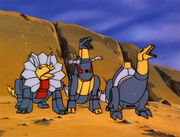
An accurate representation of dinosaur groupings
Dinosaurs are a diverse group of animals of the clade Dinosauria. They first appeared during the Triassic period, approximately 230 million years ago, and were the dominant terrestrial vertebrates for 135 million years, from the beginning of the Jurassic (about 201 million years ago) until the end of the Cretaceous (66 million years ago), when the Cretaceous–Paleogene extinction event led to the extinction of most dinosaur groups at the close of the Mesozoic Era. The fossil record indicates that birds evolved from theropod dinosaurs during the Jurassic Period and, consequently, they are considered a subgroup of dinosaurs by most paleontologists. Some birds survived the extinction event that occurred 66 million years ago, and their descendants continue the dinosaur lineage to the present day.
Dinosaurs are a varied group of animals from taxonomic, morphological and ecological standpoints. Birds, at over 9,000 living species, are the most diverse group of vertebrates besides perciform fish. Using fossil evidence, paleontologists have identified over 500 distinct genera and more than 1,000 different species of non-avian dinosaurs. Dinosaurs are represented on every continent by both extant species and fossil remains. Some are herbivorous, others carnivorous. While dinosaurs were ancestrally bipedal, many extinct groups included quadrupedal species, and some were able to shift between these stances. Elaborate display structures such as horns or crests are common to all dinosaur groups, and some extinct groups developed skeletal modifications such as bony armor and spines. Evidence suggests that egg laying and nest building are additional traits shared by all dinosaurs. While modern birds are generally small due to the constraints of flight, many prehistoric dinosaurs were large-bodied—the largest sauropod dinosaurs may have achieved lengths of 58 meters (190 feet) and heights of 9.25 meters (30 feet 4 inches). Still, the idea that non-avian dinosaurs were uniformly gigantic is a misconception based on preservation bias, as large, sturdy bones are more likely to last until they are fossilized. Many dinosaurs were quite small: Xixianykus, for example, was only about 50 cm (20 in) long.
Although the word dinosaur means "terrible lizard", the name is somewhat misleading, as dinosaurs are not lizards, representing instead a separate group of reptiles which, like many extinct forms, did not exhibit characteristics traditionally seen as reptilian, such as a sprawling limb posture or ectothermy. Additionally, many prehistoric animals, including mosasaurs, ichthyosaurs, pterosaurs, plesiosaurs, and Dimetrodon, are popularly conceived of as dinosaurs, but are not classified as dinosaurs. Through the first half of the 20th century, before birds were recognized to be dinosaurs, most of the scientific community believed dinosaurs to have been sluggish and cold-blooded. Most research conducted since the 1970s, however, has indicated that all dinosaurs were active animals with elevated metabolisms and numerous adaptations for social interaction.
Since the first dinosaur fossils were recognized in the early 19th century, mounted fossil dinosaur skeletons have been major attractions at museums around the world, and dinosaurs have become an enduring part of world culture. The large sizes of some groups, as well as their seemingly monstrous and fantastic nature, have ensured dinosaurs' regular appearance in best-selling books and films, such as Jurassic Park. Persistent public enthusiasm for the animals has resulted in significant funding for dinosaur science, and new discoveries are regularly covered by the media.
History[]
Dinosaurs were now understood to have been quick and agile, with T.rex holding its body parallel to the ground. Dinosaurs who survived the mass extinction of 65 million years ago and lived on into the present lived on the time-displaced, and energy-rich, Dinobot Island.
The most prominent saurians were the Dinobots, five rebellious (yet extremely powerful) Autobots, who proved time and again a match for an army of Decepticons. Other dinosaur Transformers are Trypticon, Sky Lynx, and the cassette warriors, Slugfest and Overkill.
MUX History[]
| This page uses content from Transformers Wiki. The original article was at Dinosaur. The list of authors can be seen in the page history. As with Transformers Universe MUX, the text of Transformers Wiki is available under the Creative Commons License. |
| This page uses Creative Commons Licensed content from Wikipedia (view authors). |
